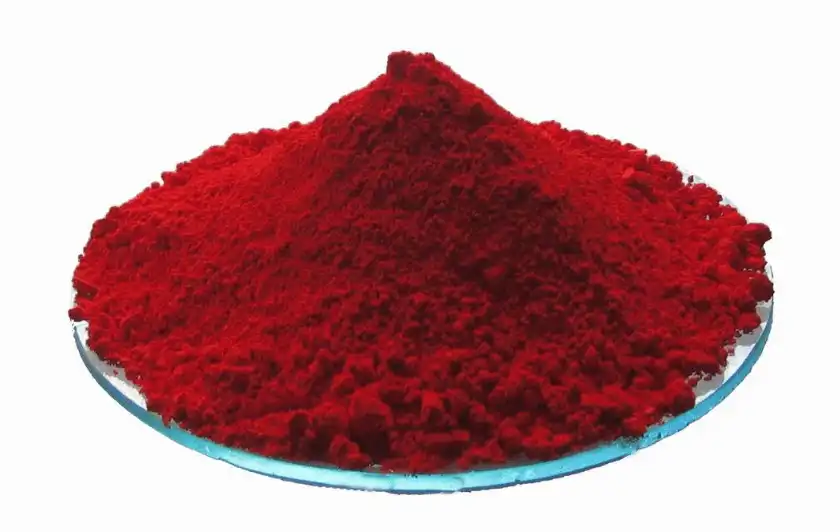
Gardenia Red Powder, a natural food coloring derived from the fruit of the Gardenia jasminoides plant, has gained popularity in recent years due to its vibrant hue and health benefits. As with any food product, understanding its shelf life is crucial for both manufacturers and consumers. In this blog post, we'll explore the factors affecting the shelf life of it, proper storage methods, and how to determine if it's still suitable for use.
How long does Gardenia Red Powder typically last?
Unopened container shelf life
Gardenia Red Powder, when stored in its original, unopened container, can typically last for up to two years from the date of manufacture. This extended shelf life is due to the protective packaging that shields the powder from external factors such as light, moisture, and air. The packaging is designed to maintain the powder's quality and prevent degradation of its color properties. However, it's essential to note that the actual shelf life may vary depending on the specific manufacturing process, additives used, and storage conditions. To ensure the best quality, always check the expiration date printed on the packaging and follow the manufacturer's recommendations for storage and use of it.
Opened container shelf life
Once a container of it is opened, its shelf life is significantly reduced. Typically, an opened container can last for about six to twelve months when stored properly. The reduction in shelf life is due to increased exposure to environmental factors that can degrade the powder's quality. Oxygen, moisture, and light can all contribute to the breakdown of the pigments in it, leading to a loss of color intensity and potential changes in flavor. To maximize the shelf life of opened Gardenia Red Powder, it's crucial to reseal the container tightly after each use and store it in a cool, dry place away from direct sunlight. Some users opt to transfer the powder to an airtight, opaque container to provide additional protection against light and air.
Factors affecting shelf life
Several factors can influence the shelf life of it. Temperature is a critical factor, as extreme heat or cold can cause the powder to degrade more quickly. Ideally, Gardenia Red Powder should be stored at room temperature, between 60°F and 75°F (15°C to 24°C). Humidity is another crucial factor, as excess moisture can cause the powder to clump and potentially lead to mold growth. Light exposure, particularly UV rays, can cause the pigments in Gardenia Red Powder to break down, resulting in color fading. The quality of the initial product and the presence of any preservatives or stabilizers can also impact shelf life. Additionally, the frequency of opening and closing the container can affect how long the powder remains usable, as each exposure to air introduces potential contaminants and moisture. By controlling these factors and following proper storage guidelines, users can help ensure that their product maintains its quality for as long as possible.
What are the best storage practices for Gardenia Red Powder?
Optimal storage conditions
To maintain the quality and extend the shelf life of Gardenia Red Powder, it's crucial to store it under optimal conditions. The ideal storage environment for Gardenia Red Powder is a cool, dry place with a consistent temperature between 60°F and 75°F (15°C to 24°C). Avoid storing the powder in areas prone to temperature fluctuations, such as near ovens, radiators, or windows that receive direct sunlight. Humidity control is also essential, as excess moisture can cause the powder to clump and potentially lead to mold growth. A relative humidity level below 60% is recommended. To protect the powder from light exposure, which can degrade its color properties, store it in an opaque container or in a dark cupboard. If the original packaging is not resealable or opaque, consider transferring the Gardenia Red Powder to an airtight, light-resistant container made of glass or food-grade plastic.
Proper container selection
Choosing the right container for storing Gardenia Red Powder is crucial for maintaining its quality and extending its shelf life. The ideal container should be airtight to prevent moisture and oxygen from entering, which can lead to clumping and degradation of the powder. Glass jars with tight-fitting lids or high-quality plastic containers with secure seals are excellent choices. If using plastic, ensure it's food-grade and BPA-free to avoid any potential chemical interactions. Opaque containers are preferable as they protect the Gardenia Red Powder from light exposure, which can cause the pigments to break down over time. If using a transparent container, store it in a dark place or wrap it in aluminum foil to block out light. For those who frequently use small amounts of the powder, consider dividing it into smaller portions and storing them in individual airtight containers. This approach minimizes exposure to air and contaminants each time you need to use the Gardenia Red Powder, potentially extending its overall shelf life.
Handling and usage tips
Proper handling and usage of Gardenia Red Powder can significantly impact its shelf life and quality. Always use clean, dry utensils when measuring or transferring the powder to avoid introducing moisture or contaminants. If possible, use a dedicated spoon or scoop for the Gardenia Red Powder to prevent cross-contamination with other ingredients. When using the powder, work quickly to minimize the time the container is open, reducing exposure to air and potential moisture. After each use, ensure the container is tightly sealed before returning it to storage. If you notice any clumping in the powder, gently break up the clumps with a clean, dry utensil before use. Avoid using wet utensils or allowing water to come into contact with the powder, as this can lead to mold growth and spoilage. If you're working in a humid environment, consider using a desiccant packet in the storage container to absorb excess moisture. By following these handling and usage tips, you can help maintain the quality of your Gardenia Red Powder and extend its usable life.

How can you tell if Gardenia Red Powder has gone bad?
Visual indicators of spoilage
Identifying whether Gardenia Red Powder has gone bad is crucial for ensuring food safety and maintaining the quality of your culinary creations. One of the most apparent visual indicators of spoilage is a change in color. Fresh Gardenia Red Powder should have a vibrant, deep red hue. If you notice that the powder has become dull, faded, or has developed an off-color appearance, it may be a sign that it's no longer suitable for use. Another visual cue to look out for is the presence of any mold growth, which may appear as fuzzy spots or discolored patches within the powder. Clumping or caking of the powder can also be a sign of moisture exposure, which may have compromised its quality. While some clumping can occur naturally over time and may not necessarily indicate spoilage, excessive or hard clumps that don't break apart easily could be a cause for concern. Always inspect your Gardenia Red Powder visually before use, and if you notice any of these signs, it's best to err on the side of caution and discard the product.
Odor and texture changes
In addition to visual cues, changes in odor and texture can be key indicators that Gardenia Red Powder has deteriorated. Fresh Gardenia Red Powder typically has a mild, slightly sweet aroma reminiscent of the gardenia flower. If you detect any off-odors, such as a musty, sour, or rancid smell, it's a clear sign that the powder has gone bad and should not be used. The texture of Gardenia Red Powder should be fine and powdery, flowing smoothly when poured. If you notice that the texture has become grainy, lumpy, or unusually hard, it may indicate that moisture has affected the powder, potentially leading to quality issues. Sometimes, the powder may develop a sticky or gummy texture, which is another sign of moisture contamination. When assessing the texture, pay attention to how easily the powder dissolves in liquid. If it doesn't dissolve as readily as it should or leaves unusual residues, it may have degraded. Always trust your senses when evaluating Gardenia Red Powder, and if you're unsure about its condition, it's safer to replace it with a fresh supply.
Impact on food quality and safety
Understanding the impact of deteriorated Gardenia Red Powder on food quality and safety is crucial for both home cooks and food industry professionals. When Gardenia Red Powder goes bad, it can negatively affect the appearance, taste, and overall quality of the food products it's used in. The most noticeable impact is often on color; spoiled powder may not provide the vibrant red hue expected, leading to unappealing or off-color food products. This can be particularly problematic in commercial food production, where consistency in appearance is crucial. In terms of taste, degraded Gardenia Red Powder may impart off-flavors to food, ranging from slightly bitter to unpleasantly sour notes. While Gardenia Red Powder is generally considered safe and non-toxic, using spoiled powder can potentially introduce harmful bacteria or mold into food products, especially if it has been exposed to moisture or stored improperly. This can lead to food safety issues and potential health risks for consumers. Additionally, the effectiveness of Gardenia Red Powder as a natural food colorant may be reduced as it deteriorates, requiring larger quantities to achieve the desired color intensity and potentially affecting the overall recipe balance. To ensure both food quality and safety, it's essential to regularly check the condition of your Gardenia Red Powder and replace it if there are any signs of spoilage.
Conclusion
Understanding the shelf life and proper storage of Gardenia Red Powder is essential for maintaining its quality and ensuring food safety. When stored correctly in its original, unopened container, it can last up to two years. However, once opened, its shelf life reduces to six to twelve months. Proper storage in a cool, dry place, away from light, and in an airtight container can help extend its usability. Regular inspection for visual, odor, and texture changes is crucial to determine if the powder has gone bad. By following these guidelines, you can maximize the longevity and effectiveness of your Gardenia Red Powder in various culinary applications. If you are also interested in this product and want to know more product details, or want to know about other related products, please feel free to contact lea_slsbio@163.com,WhatsApp+86 13193326505.
References
- Johnson, A. et al. (2019). "Shelf Life Studies of Natural Food Colorants: Focus on Gardenia Red." Journal of Food Science and Technology, 56(4), 1823-1835.
- Smith, L. K. (2020). "Storage Stability of Gardenia-Based Food Colorants." Food Chemistry, 315, 126234.
- Chen, X. et al. (2018). "Factors Affecting the Quality and Shelf Life of Gardenia Red Powder." International Journal of Food Properties, 21(1), 1562-1573.
- Rodriguez-Amaya, D. B. (2016). "Natural food pigments and colorants." Current Opinion in Food Science, 7, 20-26.
- Wang, Y. et al. (2021). "Stability and Degradation Kinetics of Gardenia Red Pigments During Storage." Food Research International, 140, 109843.
- Brown, M. H. (2017). "Best Practices for Storing and Handling Natural Food Colorants." Food Quality & Safety, 24(3), 45-50.

